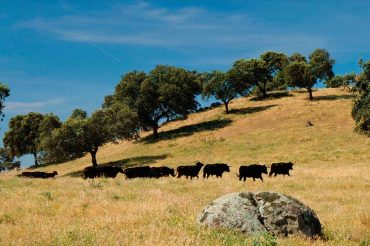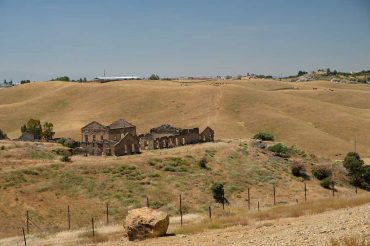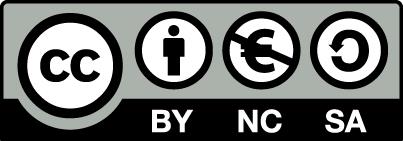INTRODUCTION
Orellana Perdiz is a multi-functional farm owned and managed by three sisters in the north of the province of Jaén, on a property where the ruins of the castle that gave its name to the Battle of Navas de Tolosa are located, between some old silver and lead mines.
The main activity of the farm is the breeding of fighting bulls, bulls braves, which are raised on the farm of 300 ha, 100 ha for cows and 200 ha for bulls.
In addition, the sisters also have differentiated activities that complement their main agricultural activities, this includes tourism, restaurants and hotels. Their gourmet products such as partridge pâté and pickled partridge, made in a traditional way and in small batches. These are sold in the facilities themselves and in gourmet shops throughout Spain.
They employ 25 to 30 people in all the companies. Through these diverse activities, they maintain the cultural heritage of their region and the land, such as the landscape, the dehesa. The management of the land allows the conservation of the dehesa, as well as the bulls to breed.

The main difficulty is that we ourselves differentiate between
men and women. In my sector there is no need for such a differentiation.
Women are more detail-oriented, they manage the details better in terms of customer service.
1. PERSONAL DATA
Name
Pilar Orellana Pérez
Age Range
46 +
Education
Middle school. Master of Business Administration and Management.
Occupation
Pilar is in charge of the hotel and catering department and, depending on the season and the workload, she participates in rural tourism and agricultural activities. She also attends gastronomic fairs to present her products related to partridge and olive oil.
2. FARM PROFILE
Address/coordinates
Andalusia Highway A4 South, Km 265, La Carolina (Jaén).
Farm Area in ha
300 ha in total. 100 for the cows and 200 for the bulls.
Date since when the female entrepreneur owns/rents the farm:
In 1948 Pilar Orellana’s father started the hotel business and a small restaurant was created. Later he bought the farm and the cattle ranch, pursuing his dream.
Nº of workers on the farms
| FULL TIME | |
|---|---|
| Family members | Other than family members |
| 4 | |
| PART-TME/SESONAL | |
|---|---|
| Family members | Other than family members |
| 15-20 | |
| WOMEN | |
|---|---|
| Family members | Other than family members |
| 3 | |
Farm description
On the farm there is a part of the farm that is for cattle and another part where the cows are for meat, of the limousine breed. The livestock is distributed in farms, from different municipalities of the province. They are organic farms, except for the part of the cows that cannot be certified due to their special diet, as they need extra feed. In spite of this, their meat is very natural and appreciated because they are raised in freedom. Barley and heather are planted on the farms, all of which provide nitrogen to the soil. By adjusting the livestock load, with the sown fodder, the livestock is maintained. The holm oaks are pruned and with it they obtain firewood for the hotel business (chimneys, ovens, etc.) and also the following year, the non productive holm oaks give acorns and in this way the pasture is enriched. The aim is to achieve a sustainable economy.
Within the properties there are mining vestiges that belong to the General Catalogue of Andalusian Mining Heritage, which can be accessed through guided tours organized by the company. Bullfighting visits are also organized in all-terrain vehicles to discover the world of bullfighting. On the farm we can find the ruins of the Castle of Las Navas de Tolosa, name coined by the battle of Las Navas de Tolosa, where the Christians defeated the Arab troops, on July 16, 1212.
3. MULTIFUNCTIONALITY / RURAL CULTURAL HERITAGE
The brand is Orellana Perdiz and from there all the activities are generated. They have managed to make each of the activities work independently. Pilar attends food, livestock or any other kind of fairs, selling her products but at the same time is making the Orellana Perdiz brand known and simultaneously promoting the rest of the activities.
In this way she is known nationally and her facilities (restaurant and hotel) are next to the motorway, a very busy area, bringing in a great deal of international clientele.
He comments that they are currently facing a technological challenge and that companies have to adapt because they are immersed in a changing business model.
Among the activities carried out by Orellana Perdiz are livestock breeding, catering, rural accommodation, guided cultural visits and the production of gourmet products, with partridge as the main element of its products. Its recipe has been transferred between generations, a heritage to which only some members of the family have access, with the transfer of this culinary legacy being a family event. They have managed to make their partridge a brand name and this is complicated by being a small company.
Guided tours are available on all terrains and there are different packages. Some visits are more oriented to know the world of the bull and the natural environment in which they are raised, the dehesa in this case, and other visits are oriented to the cultural heritage of the area. In the visits they explain their most recent history of mining, mining heritage that is classified as Andalusian heritage and also talk about the Battle of Navas de Tolosa, which gave name to the castle located on one of its farms.
4. CONSIDERATIONS, TRAINING / COMPETENCES INVOLVED
- General considerations
- Training/Competences (Knowledge, Skills, Attitudes) especially relevant for the process
Among the challenges they face is the economic issue. What they have generated from profits they have always invested in their own business or activities. They like to be serious about the suppliers who are a very important part. They do not skimp on price but in return they have to serve them top quality products.
Another problem arises when they have to organize themselves to manage all the activities because they may have a small structure and do not know if they should increase it.
Another important challenge is the bureaucratic issue. By having different activities they have more work to do in order to comply with all the regulations, because they have to carry out inspections, audits and they have to keep an eye on a large volume of documentation and that is very time consuming. They have to be very clear about their income, where they come from and where they are going; they have to have good management in general because they have different agreements that have to be complied with. They have legal and labor advisors but they are in charge of managing everything, they worry about knowing the regulations and that means a lot more work.
Your age and the amount of time you’ve spent at the head of the company influence how you deal with problems. The different activities, the problems and the bureaucracy are affected in a different way when you are young and start a project with enthusiasm.
The cultural heritage gives the activity differentiation and this is what makes them unique. They still need to improve in the commercial area because they have a lot of heart and should value themselves more.
Training/Competences (Knowledge, Skills, Attitudes) especially relevant for the process:
When they started the activity they had no specific training, only experience gained over the years. Pilar did a Master in Business Administration and is always in a continuous process of training, doing courses in gastronomy, oil, tasting, tourism, marketing, castles and battles, cultural heritage, etc. organized by different entities.
According to Pilar the companies are lively and it is very easy to get a good heritage but it is also very easy to lose it. The person who manages it has a lot of influence: the will of the person, the sacrifice. You have to have faith and believe in what you are doing because it is a long process of several years and that is going to take a lot of your time and money.
You have to fight to make the entrepreneur’s life easier. Sometimes there is no transition from parents to children because the children have seen their parents suffer a lot because of their work and they don’t want to go through the same thing. That is why they try to get more education, for example by going to university, so that they can live better.
Nowadays there are too many rules to follow, too many requirements, too many taxes and that makes those who come after them not interested in continuing with the company.
His father started with the hotel business in 1948 and later bought the farm and the livestock. Pilar was the one who oriented the business towards rural tourism. They were pioneers in discovering this market niche, but devoting themselves to gastronomy, making products with partridge, has taken up a lot of their time.
It is work that involves a great deal of sacrifice. They are a family of very humble origins that have been making themselves. The lack of money makes them sharpen their wits. They are very restless and nonconformist.
They always listen to their workers’ opinions and that helps them. They believe that the staff must be motivated, involved; they make the staff see that they are not anonymous people, thatthey are important for the company.
Comprehensive and coherent product catalogue.
Combination of cultural heritage, agro-tourism and agriculture.
Management of suppliers and employees.
Proactivity, entrepreneurship and vanguard.
Commitment to quality and detail management.
Understanding of family cooperation.
Illusion and vision of the future.
Well-developed image and brand.
Ability to sacrifice.
Experience and openness to continuous learning.
Need to maintain a number of profitable and manageable business lines.
A great diversity of activities that makes integral management difficult.
Need to improve dissemination and marketing strategies.
Greater integration in national and international offers of agrotourism and cultural tourism.
Increase support from institutions through networks, certifications and quality seals.
Increase activity in terms of marketing and commercialization.
To find a potential market niche close by and of value.
Bureaucratic complexity with multiple regulations for each activity.
Social movements against the brave bull.
Lack of generational change.













